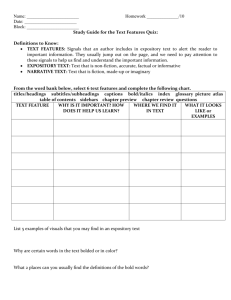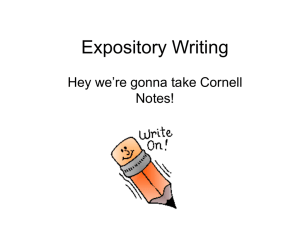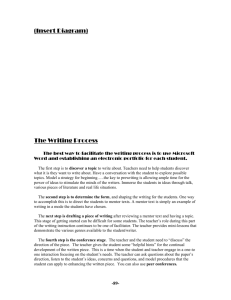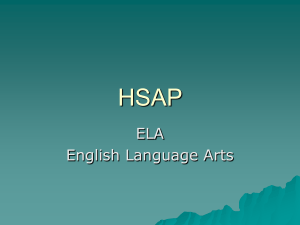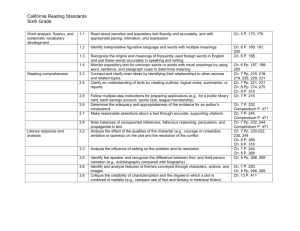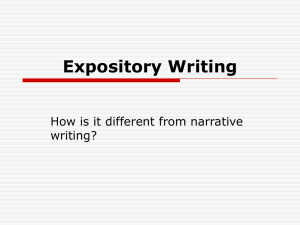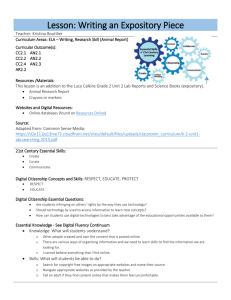Expository Texts
advertisement
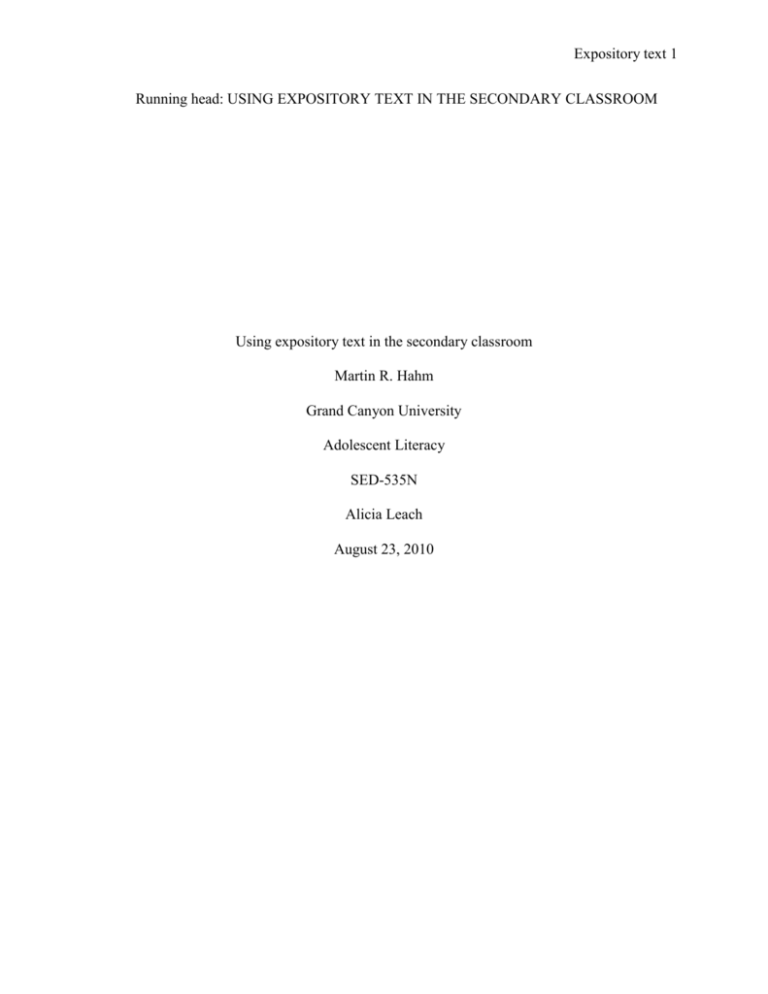
Expository text 1 Running head: USING EXPOSITORY TEXT IN THE SECONDARY CLASSROOM Using expository text in the secondary classroom Martin R. Hahm Grand Canyon University Adolescent Literacy SED-535N Alicia Leach August 23, 2010 Expository text 2 Using expository text in the secondary classroom Introduction “Just the facts, ma'am, just the facts.” On “Dragnet,” one of the first TV shows investigating crime, Sergeant Joe Friday and his partner interview witnesses asking for the facts, just the facts (The Internet Movie Database [IMDb], 1990-2010). While each episode is imbedded in a narrative adventure, the investigation pretty well summarizes an exclusive interest in expository information, the facts. Even modern versions of criminal investigation as CSI (Crime Scene Investigation) focus on using new technology to retrieve just the facts. The information offered is expository. Classrooms today, especially upper elementary or middle school and secondary, are intent on students growing in beneficial use of expository texts. It is a requirement not only to increase learning from this medium, but also in producing evidence of their learning and unique gifts and abilities by writing expository text. Reading expository text and writing in the expository format is essential for college students today. The definition Is it just the facts? What is expository writing? “Exposition is a type of oral or written discourse that is used to explain, describe, give information or inform” (Sanford University, n.d.) It’s an alternative to narrative text. Most material read today is expository text and includes textbooks for our students, essays, government materials, legal documents, speeches, lab procedures, directions, journals, newspaper reports, and magazine articles among many possibilities. Some characteristics are shared, but uniqueness of styles, structures and features requires students learn how to read for maximum appreciation and benefit. “Expository texts,…. explain something by definition, sequence, categorization, comparison-contrast, enumeration, process, problem-solution, description, or cause-effect. Where the narrative text uses story to Expository text 3 inform and persuade, the expository text uses facts and details, opinions and examples to do the same” (Burke, n.d.). Expository text is different from narrative; however, segmented expository text may be found within narrative and narrative use expository text can also be used to provide facts for its story. Documentaries and TV dramas provide examples of such mixing. Perhaps this is a strategy which will yet be developed to assist students in comprehending expository text better. Disadvantages Comprehending expository text is difficult for a variety of reasons. One is the variety of text structures and content information that is still unfamiliar to students. “The organization and structure of the text is inconsistent and unpredictable, and for the first time, children are required to read to learn (Italicized instead of quotes)” (Bakken & Whedon, 2002, p. 230). A study referenced by Joanna P. Williams stressed focusing on vocabulary and strategies for better comprehension. “A rationale for teaching comprehension strategies is that readers derive more meaning from text when they engage in intentional thinking (Italics added)” (2005, p. 6). Vocabulary is especially important since many new terms and concepts are introduced, but that can be turned to success for students in teaching syllabication and demonstrating how morphemes and phonemes provide meaning and information even before finding suitable definitions and explanations for terms and concepts. Thus links to prior knowledge become cords being woven to acquire more learning even if these threads are fragile at first. Other reasons expository text is difficult is not only structure and new vocabulary, but that the students may also have fallen behind in decoding skills, have low level fluency and other literacy problems (Irvin, Meltzer, & Dukes, 2007, p. 59-60). They suggest six aspects where text becomes extra complex are: “Relationships:..Richness: ….Structure: ….Vocabulary: … Expository text 4 Purpose:….” (2007, p. 61). These, of course, can be addressed with a positive view of using the challenges to develop successful strategies in comprehending expository text and appreciating its advantages. Advantages Almost all non-fiction literary material is expository. It’s the widest source of information we have. We meet it every day in our lives. In school it’s a required part of earning grades by doing reports, passing exams, and completing meaningful research projects. In the everyday workplace information is provided and required with memos, reports and prospecti. In politics and government speeches and legislation propose, expose and are exposited. (Sanford University, n.d.). The information highway, the internet, likewise is paved with expository writing lined with graphics to clarify and persuade. What vehicles will we offer? What roadmaps to reach their destinations, to achieve goals and even go beyond to discover new horizons? More strategies for increasing comprehension of expository text One strategy continues a practice commonly used in lower grades. The students are encouraged to think aloud, to discuss what they’ve read. They interactively work with classmates and teacher, practicing, modeling, emulating and developing learning skills as they think out loud: While thinking aloud during shared reading may seem like old news to teachers in grades K–5, we found as we visited the classrooms of middle and secondary teachers in three large urban schools (one middle and two high schools) that we were unlikely to see this type of instruction (Lapp, Fisher, & Grant, 2008, p. 378). Expository text 5 Thinking out loud may seem and become disruptive, but apparently it has proven successful, especially where students are coming from a variety of cultures and linguistic backgrounds. Selecting content area texts and reading material with a purpose, to engage students in material that will hold their interest, became this teacher’s goal in selecting a new textbook series in 2007. This underscores what an adolescent literacy website advocates: “The goal increasingly becomes for children to develop a real joy of reading that propels them to read frequently and widely” (AdLit.org: Adolescent Literacy, 2002, p. 1). Obvious strategies that need repeating are encouraging students to scan material and not get bogged down or frustrated. Encouraging students to check pictures and diagrams becomes an incentive to delve deeper to learning more of the content matter. Checking the headings, sections or bold print can give clues for further follow-up. Problems and solutions, main ideas, and self-monitoring can lead to retelling information, sharing with partners in small groups or teacher and teacher assistant and making charts, webs and outlines. Some students enjoy using their artistic talents with drawings with which this essayist continues to be impressed among his Native American friends. Using strategies to learn and review vocabulary, having students practice writing what they’ve read or researched and cooperative learning, some of which has been considered, are stressed by AdLit.org website (2002). Graphic organizers offer a wide variety of opportunities to increase comprehension as well as develop metacognitive methods for mind mapping (Mind Tools Ltd, 1995-2010) and mastering concepts. Below, for example, a graphic organizer for Expository text 6 description of a topic by listing characteristics, features, or examples. The Olympic Symbol has five interlocking rings to be matched with colors, countries, etc. Description: The next can be for sequence, perhaps listing dates when Olympic Games were held. Or for steps in carrying out a science experiment. Sequence The next would be comparing and contrasting. One could compare the games then with the Olympic Games today. Or arachnids and insects. Comparison: Expository text 7 Using the following for a science project could illustrate man’s effect on the environment. Or continuing with the Olympic Games, it shows how the games then and now have an effect on the fans. Cause and effect: The problem and solution organizer could be used in science for showing problems of obtaining fossil fuels compared to other sources of energy in cost or adding other problems with solutions to be discussed or offered; Problem—solution The above graphic organizers and information about expository writing are from The Expository Writing Program (EWP), a University of Michigan-sponsored program (Sanford University, n.d.). In addition to the many sites suggested in the previous essay, Glencoe Publishing is regularly offering copyrighted graphic organizers. In one the teacher provides the questions and students the answer with pages referenced. In a bulls-eye graphic organizer the main ideas is at the center with questions about headings, subheadings to the outer rings. (Glencoe/McGraw-Hill, 2000-2005). If the saying about necessity being the mother of invention is in any way somewhat true, developing original organizers with more specific purposes will continue to make Expository text 8 comprehending expository text more lucid. That’s a fact, even if the source of that saying is unknown. Conclusion with The facts Ivey and Fisher ask in Appendix B of their textbook, “Why isn’t appropriate literacy instruction already being provided to adolescents” (2006, p. 127)? They present their case. They offer seven principles to state the facts about what adolescents deserve. Of the seven principles proposed the seventh rounds them all out: “Adolescents deserve homes, communities, and a nation that will support their efforts to achieve advanced levels of literacy and provide the support necessary for them to succeed” (Ivey & Fisher, 2006, p. 127-136). How will our students cruise down the superhighway of information? The facts, just the facts, continue the drama of life in a world of information-sharing, placed out there, exposited, by and for students of all ages. Expository text 9 References AdLit.org: Adolescent Literacy. (2002). http://www.adlit.org/article/3416 Bakken, J. P., & Whedon, C. K. (2002, March). Teaching text structure to improve reading comprehension. Intervension in School and Clinic, 37, 229-233. Retrieved from http://web.ebscohost.com.library.gcu.edu:2048/ehost/detail?vid=3&hid=17&sid=0299aed d-2f5d-4fa1-83afcc2ff6d6bf9a%40sessionmgr13&bdata=JnNpdGU9ZWhvc3QtbGl2ZSZzY29wZT1zaXR l#db=ehh&AN=6298013 Burke, J. (n.d.). Reading reminders: Tools, tips, and technique. Retrieved August 21, 2010, from http://www.englishcompanion.com/room82/readexpository.html Glencoe/McGraw-Hill. (2000-2005). Reading success with expository texts. Retrieved August 25, 2010, from http://www.glencoe.com/sec/teachingtoday/weeklytips.phtml/146 Irvin, J. L., Meltzer, J., & Dukes, M. (2007). Taking action on adolescent literacy. [Adobe Digital Edition]. doi: 1009-0001-148C-0000148D Ivey, G., & Fisher, D. (2006). Creating literacy-rich schools for adolescents. [Adobe Digital Edition]. doi: 1009-0001-1556-00001557 Lapp, D., Fisher, D., & Grant, M. (2008, February). “You can read this text—i’ll show you how”:Interactive comprehension instruction. J O U R N A L O F A D O L E S C E N T & A D U L T L I T E R A C Y, 51, 372-383. Retrieved from http://library.gcu.edu:2048/login?url=http://search.ebscohost.com/login.aspx?direct=true &db=ehh&AN=29345979&loginpage=Login.asp&site=ehost-live&scope=site Mind Tools Ltd. (1995-2010). Mind maps: A powerfull approach to note taking. Retrieved August 25, 2010, from http://www.mindtools.com/pages/article/newISS_01.htm Expository text 10 Sanford University. (n.d.). Information about expository writing. Retrieved August 25, 2010, from http://www.stanford.edu/~arnetha/expowrite/info.html The Internet Movie Database. (1990-2010). Dragnet TV series 1951-1959. Retrieved August 25, 2010, from http://www.imdb.com/title/tt0043194/ Williams, J. P. (2005, Spring). Instruction in reading comprehension for primary-grade students: A focus on text structure. The Journal of Special Education, 39, 6-18. Retrieved from Criteria Achievement Level Unsatisfactory Less than Satisfactory Satisfactory An overview 0 points of expository An essay text and the discussing advantages expository text was not and disadvantages completely of its use in developed. content-area classrooms. Five uses for expositorytext application and associated graphic organizer. 0 points Five uses for expository text in content-area classrooms and the associated graphic organizers were not developed. 0 points Thesis Development Paper lacks any and Purpose discernible overall purpose or organizing claim. Argument 0 points Logic and Statement of Construction purpose is not justified by the conclusion. The 1.56 points 1.8 points An essay An essay discussing the discussing the advantages advantages and and disadvantages disadvantages of using of using expository text expository text in content-area in content-area classrooms classrooms was created, developed and but lacked balanced. balance. Good Excellent 2.04 points 2.4 points An essay An essay discussing the advantages and disadvantages of discussing the using expository text in content-area classrooms was welladvantages defined, balanced in its presentation, well-researched, and and fully developed. disadvantages of using expository text in content-area classrooms was welldefined, wellbalanced, and welldeveloped. 1.17 points 1.35 points 1.53 points 1.8 points Five Five Five Five applications for using expository text effectively in applications for applications for applications for content-area classrooms were fully described and using using using applications documented for them to connect graphic expository text expository text expository text organizers for use in practicum activities. effectively in effectively in effectively in content-area content-area content-area classrooms classrooms classrooms were described were described were fully but were not and graphic described and connected to organizers graphic the use of examined for organizers graphic use in presented organizers practicum appropriately examined for activities. for use in use in practicum practicum activities. activities. 0.27 points 0.32 points 0.36 points 0.42 points Thesis and/or Thesis and/or Thesis and/or Thesis and/or main claim is comprehensive; contained main claim is main claim is main claim is within the thesis is the essence of the paper. Thesis insufficiently apparent and clear, statement makes the purpose of the paper clear. developed appropriate to forecasting and/or vague; purpose. development purpose is not of the paper. It clear. is descriptive and reflective of the arguments and appropriate to the purpose. 0.31 points 0.36 points 0.41 points 0.48 points Sufficient Argument is Argument Clear and convincing argument that presents a persuasive justification of orderly, but shows logical claim in a unique and compelling manner. All sources are claims is may have a few progressions. authoritative. lacking. inconsistencies. Techniques of Expository text 11 conclusion does not support the claim made. Argument is incoherent and uses noncredible sources. Mechanics of 0 points Surface errors Writing (includes are pervasive enough that spelling, punctuation, they impede grammar, communication language use) of meaning. Inappropriate word choice and/or sentence construction. Paper Format: 0 points Template is not (Use of appropriate used style for the appropriately or major and documentation assignment) format is rarely followed correctly. Research 0 points Citations No reference page; no (In-text citations for citations paraphrasing and direct quotes, Reference page listing and formatting; as appropriate to assignment and style) Argument lacks consistent unity. There are obvious flaws in the logic. Some sources have questionable credibility. The argument argumentation presents are evident. minimal Smooth justification of progression of claims. claims from Argument introduction to logically, but conclusion. not thoroughly, Most sources supports the are purpose. authoritative. Sources used are credible. Introduction and conclusion bracket thesis. 0.2 points 0.23 points 0.26 points 0.3 points Frequent and Some Prose is Writer is clearly in command of standard, written academic repetitive mechanical largely free of English. mechanical errors or typos mechanical errors distract are present, but errors, the reader. are not overly although a few Inconsistencies distracting to may be in language the reader. present. Uses choice Correct a variety of (register), sentence sentence sentence structure and structures and structure, audienceeffective and/or word appropriate figures of choice are language. speech. present. 0.2 points 0.23 points 0.26 points 0.3 points Appropriate Appropriate Appropriate A broad understanding of APA format and style is evident Template is Template is Template is in use of level headings and lists, for example. used, but some used; fully used; elements are Formatting is There are missing or correct, virtually no mistaken; lack although some errors in of control with minor errors formatting formatting is may be style. apparent. present. 0.2 points 0.23 points 0.26 points 0.3 points Reference Reference Reference In-text citations and a Reference Page are complete. The page is Page is Page is documentation of cited sources is error-free present; included which present and Citation is lists sources fully inclusive inconsistently used in paper; of all cited used Sources are sources; appropriately Documentation documented, is appropriate although some and citation errors may be style is usually present correct Martin, Great Job! I enjoyed reading your paper and truly love the connection you made in your introduction to “Dragnet”.
